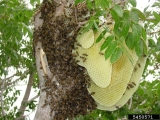
Facts about Africanized Honey Bees
The Africanized honey bee (AHB) has migrated steadily northward since its accidental release from a breeding program in Sao Paulo, Brazil in 1957. The bees entered California in 1994 and have now completely colonized Imperial, Riverside, San Bernardino, San Diego, Orange, Los Angeles, Ventura, Kern, Kings, and Tulare Counties. The northern edge of the AHB migration reached portions of Santa Barbara, Fresno, Madera and Inyo Counties. Although Africanized honey bees are currently not found in San Mateo County, they are expected to eventually migrate up the coast into northern California.
Compared to the European honey bee found throughout the United States, Africanized honey bees are much more aggressive when defending their hive. They are more easily provoked, respond in greater numbers and are defensive over a larger area. Individuals that are sensitive to bee venom, senior citizens, small children, outdoor workers, and pets or livestock in confined outdoor areas are especially at risk from multiple bee stings.
In order to plan and prepare for these public health impacts, the San Mateo County Agricultural Commissioner sponsored the formation of the Africanized Honey Bee Task Force for San Mateo County. Task Force representatives from 21 local agencies and organizations have drafted an AHB Action Plan that outlines strategies for providing:
- public education on AHB;
- effective emergency medical response for multiple stinging incidents; and
- non-emergency pest control for the removal of swarms or hives that pose a threat to public safety.
Review a current map of Africanized honey bee distribution in California.
Africanized honey bee Fact vs. Fiction.
The following agencies can provide additional information on the Africanized honey bee:
San Mateo County Agricultural Commissioner
728 Heller Street, P.O. Box 999
Redwood City, CA 94064-0999
(650) 363-4700 Fax (650) 367-0130
- Information: AHB migration updates, bee biology/behavior, educational brochures, AHB training/certification of pest control professionals
- AHB Action Plan: Copies of the Africanized Honey Bee Action Plan for San Mateo County are available on request
- AHB Identification: Samples of suspect Africanized honey bees can be submitted for laboratory analysis and determination
- Multiple Stinging Incidents: Call 911 for emergency response and medical assistance
- To Report Multiple Stinging Incidents: Emergency responders, physicians, hospitals and clinics should report multiple stinging incidents to the Agricultural Commissioner within 48 hours at (650) 363-4700
San Mateo County Mosquito Abatement District
1351 Rollins Road
Burlingame, CA 94010
(650) 344-8592 Fax (650) 344-3843
- Information: Educational materials and brochures
- Bee Removal: Suppression of bee swarms and non-structural exposed colonies
U.C. Cooperative Extension
80 Stone Pine Road, Suite 100
Half Moon Bay, CA 94019
(650) 726-9059 Fax (650) 726-9267
- Information: Brochures, bee biology and behavior, public/homeowner information on prevention and planning, non-emergency bee questions
San Mateo County Environmental Health Department
2000 Alameda de las Pulgas, #100
San Mateo, CA 94403
(650) 372-6200 Fax (650) 627-8244
- Information: Brochures, bee biology and behavior
San Mateo County Public Health Officer
Dr. Scott Morrow
225 37 th Avenue
San Mateo, CA 94403
(650) 573-2757 Fax (650) 573-2397
- Information: Updates available for physicians and other medical personnel on the clinical manifestations and medical management of bee stinging victims